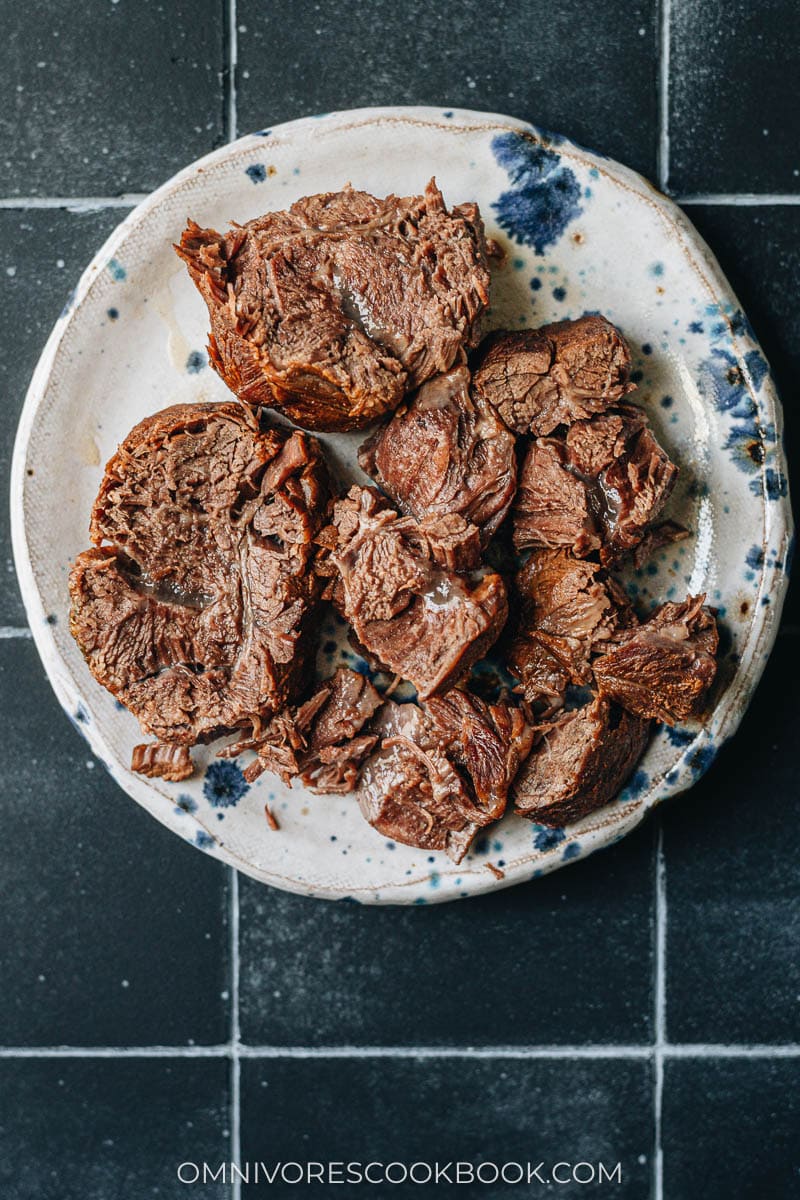
Chinese braised beef shank, or Jiang Niu Rou, is a popular cold-cut dish that you can get either at a restaurant or from the deli counter of a regular grocery store. The beef shank is slowly cooked in a master sauce with a soy sauce base and various spices, until tender and infused with a decadent savory aroma. You can simply slice the beef and eat it by itself – paired with cold beer as an appetizer if you like to follow custom. You can also make a quick beef salad with a spoonful of the braising broth and chili oil. Personally, I love to use the braising liquid to make a 20-minute noodle bowl, topped with chunks of the braised beef shank.
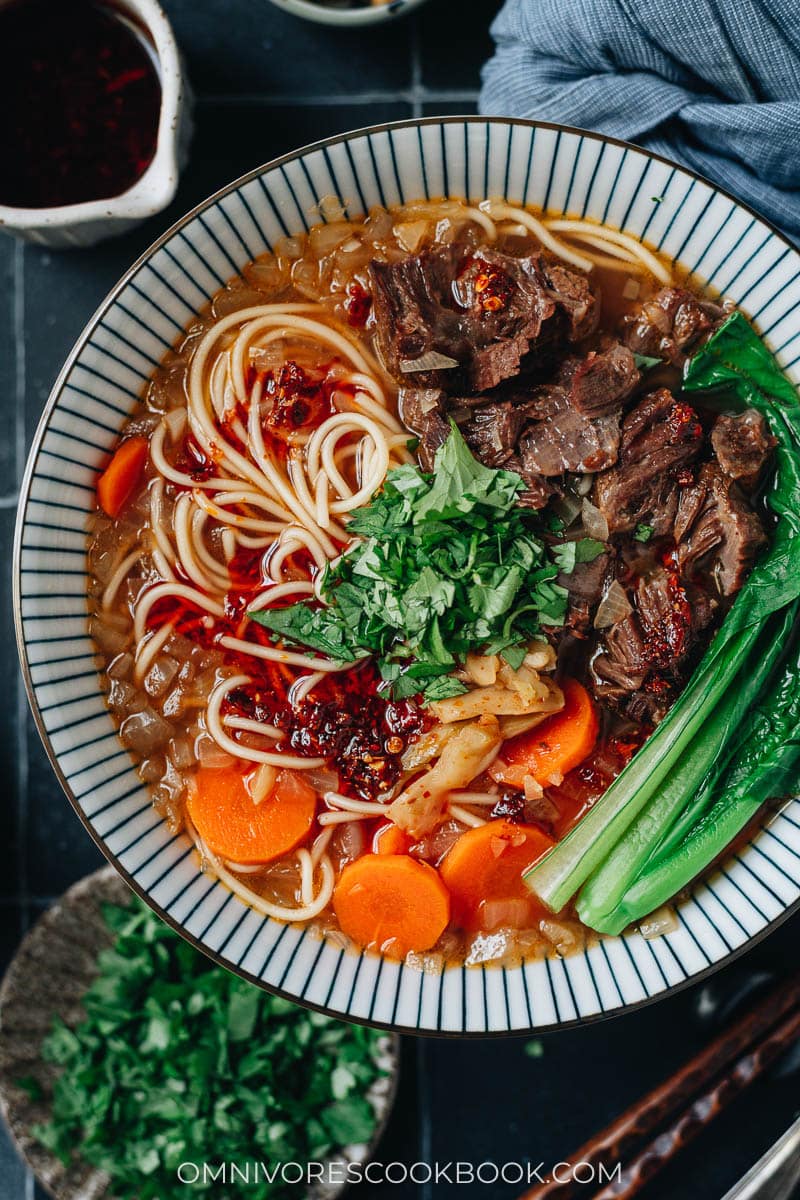
Why this recipe
Traditionally, Chinese braised beef shank is prepared in a very delicate way to maximize the flavor. For example, the beef is often soaked in cold water for hours to get rid of the blood and give the meat a cleaner taste. Many restaurants also marinate the meat before braising to enhance the flavor. The beef is often braised until just cooked through, so it’s easy to slice very thinly.
In my home cooked version:
- The prep time is shortened a lot by skipping the soaking and marinating. Yes, the extra steps do help with the flavor, but I found them less important than using a very balanced and seasoned braising broth.
- The braising liquid spices are curated and shortened, so you can easily source all the ingredients from a grocery store. The traditional Chinese beef shank braising spices often include Chinese herbs such as tsao guo and sand ginger. Sometimes it’s a challenge to source those fresh high quality ingredients in the US to actually make an impact on the dish. That’s why I replaced them with black cardamom and ginger, which have very similar flavor profiles and are easy to find.
- I cut up the meat and braised it for a longer time for a more tender result. Back in China, I often found the beef shank a bit too tough for my taste. When I made it at home for this recipe, I accidentally cooked it too long and the meat almost fell apart. I LOVED the result. So I decided to share this version because I think the texture is superior to the traditional one. If you prefer the chewy texture, simply chill the beef in the fridge and the meat will toughen up so you can serve it as a cold dish.
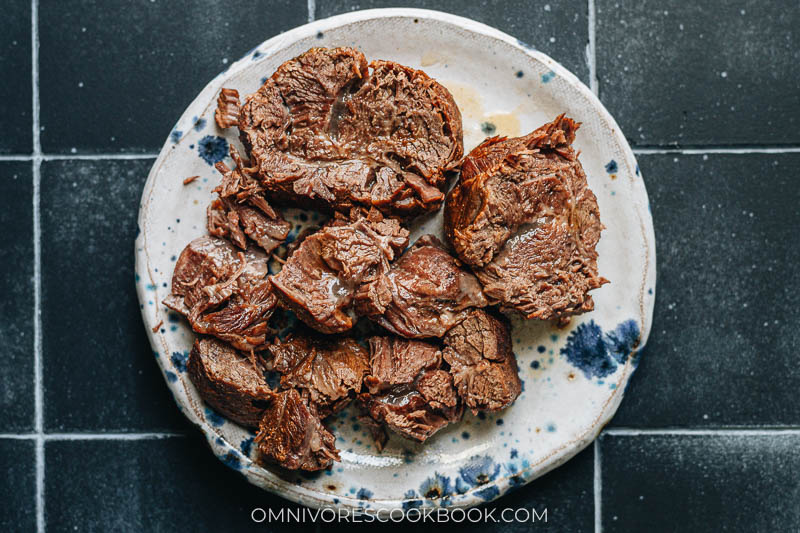
Ingredients
Why beef shank
Beef shank (or beef shin) is the leg portion of a cow. The cut is muscly, lean, tough, and full of connective tissue. However, once cooked low and slow, or using a pressure cooker (Instant Pot), the connective tissue melts away and the meat becomes juicy and tender. In fact, it’s one of the best cuts for stews and braised dishes. Because the lean muscle is quite short and protected by the connective tissue, when braised, it has a softer and juicier mouthfeel and is less stringy than some of the more expensive cuts.
On the other hand, if you cannot find beef shank, it’s totally OK to use other cuts such as chuck, brisket, or short ribs.

Soy bean paste
A key ingredient in this recipe is soy bean paste, or Huang Dou Jiang (黄豆酱). You may also see it labeled as “ground bean paste” or simply “bean paste”. The soy bean paste is made with fermented soybeans. It tastes savory and salty, like soy sauce but with a richer flavor and denser texture.
If you cannot find soy bean paste, Chinese sweet bean paste (甜面酱) is the next best thing. Alternatively, you can also replace it with oyster sauce or black bean sauce. The flavor profile of the dish will change but remain delicious.
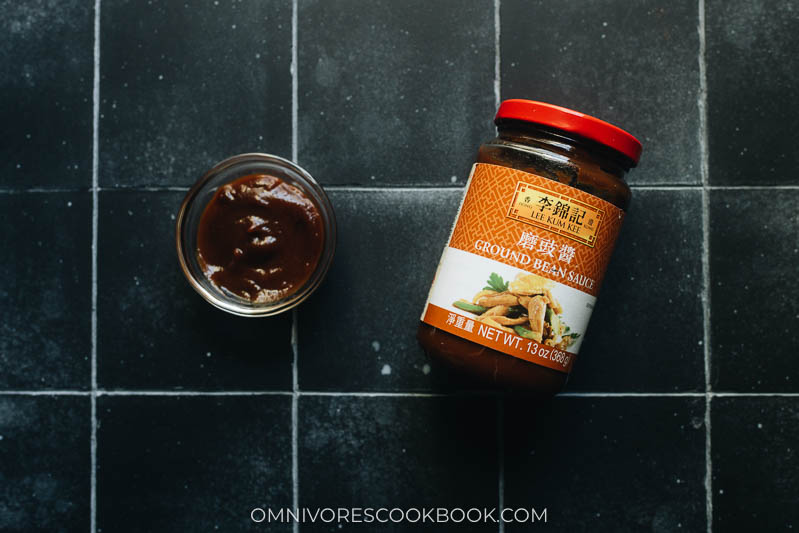
Braising ingredients
I’ve tried my best to shorten the ingredient list and use species you can easily find. If you often braise meat, you probably already have most of them.
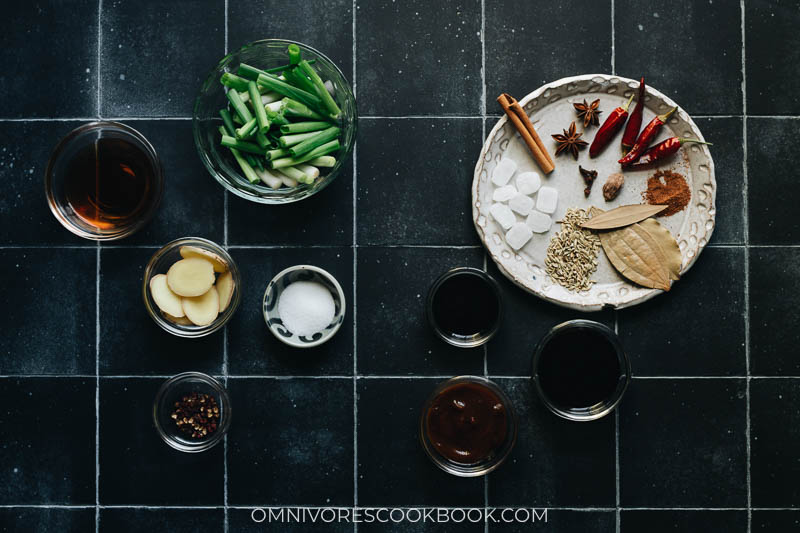
Cooking process
Once you’ve gathered all the ingredients, the cooking couldn’t be simpler:
- Cover the beef with cold water and add the aromatics
- Boil the beef and skim the foam from the top. This step gets rid of the impurities from the broth and makes it clearer
- Add the rest of the braising ingredients
- Pressure cook or cook on the stovetop until the beef turns tender
I highly recommend using a pressure cooker or an Instant Pot for this one, because it shortens the cooking time by a lot. The beef will be so tender that you can cut it with a fork.

How to serve Chinese braised beef shank
- Serve it by itself, hot or cold
Once you’re done cooking, you can simply serve the braised beef shank with some braising liquid. The meat is super tender and pairs perfectly with steamed rice. The meat will become more flavorful if you soak it in the cooking liquid for a day or more, but I simply add a spoonful of the broth onto my rice when I eat it. It’s so delicious!
You can also wait for the meat to turn cold, slice it thin, and serve it as a cold appetizer. It works nice in the summer with a glass of cold beer.
- Make a quick beef salad
I shared this super quick beef salad recipe that uses the braised beef shank and braising broth. By adding celery, cilantro, and peanuts, the texture of the dish becomes much more interesting. A generous pour of homemade chili oil is a must!
- Super fast beef noodle soup
This 20-minute beef noodle soup is a perfect one-bowl meal for any time of day. You can put it together with just a handful of ingredients, using the braising liquid as the soup base and the tender beef chunks as topping.
How to use the leftover braising liquid
The beautiful thing about the Chinese braised beef shank is, you can reuse the braising liquid again and again. That’s why some people call it “thousand year sauce”. When you re-use it, ideally you should top it off with more liquid and extra spices, so the amount of the broth remains unchanged. However, here are a few ways to use the broth easily:
- Cook a few soft boiled eggs like you normally would and use the broth to marinate the eggs. The egg yolk will be cured in the broth and taste heavenly.
- Braise the tofu in the broth with a touch of chili oil. It’s one of my favorite ways to enjoy tofu because it is infused with a rich flavor and tastes so good.
- Use the broth as a base to poach chicken. The idea is similar to soy sauce chicken, but the chicken will turn out richer because the braising liquid has the beefy essence.
- You can also use a small amount of the broth to braise or stir fry vegetables. For example, when my mom makes the braised napa cabbage, she always uses broth instead of water and oyster sauce to create a delicious base.

Afterthought
Chinese braised beef shank is a humble yet very versatile dish. It is perfect for meal prep and cooking in advance because you can use the meat and broth to create many other dishes throughout the week. I hope you enjoy it as much as I do!
Other recipes you might like
- Chinese Pork Belly Bun (Rou Jia Mo, 肉夹馍) – Tip: try using the Chinese beef shank to replace the braised pork!
- Easy Hand-Pulled Noodles – serve this beef over hand-pulled noodles to impress your friends!
- Bean Sprout Stir Fry – a great side dish to go with this one
- Easy Chinese Cucumber Salad (拍黄瓜) – a classic cold appetizer that’s great with everything
- Real Deal Sesame Noodles – Use 1 to 2 tablespoons of beef broth to replace the water in this recipe and boost your noodles!
Chinese Cooking Made Easy
Are you new to this website? This free email series is a great place to start. I’ll walk you through a few of my most popular recipes and show you how and why they work. You’ll quickly start to cook better Chinese food in your own kitchen.
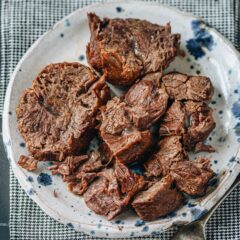
Chinese Braised Beef Shank (酱牛肉, Jiang Niu Rou)
Ingredients
Blanching
- 2 to 3 lbs (1 to 1.4 kg) beef shank (shin) , sliced to large bite-size pieces (*Footnote 1)
- 2 tablespoons Shaoxing wine (or dry sherry)
- 4 green onions , cut into 2” (5 cm) long pieces
- 1 thumb ginger , sliced
- 1 teaspoon Sichuan peppercorns
Braising
- 2 tablespoons soybean paste (or sweet bean paste) (*Footnote 2)
- 2 tablespoons light soy sauce
- 1 tablespoon dark soy sauce
- 4 Chinese dried chili peppers
- 3 bay leaves
- 3 cloves
- 2 whole star anise
- 1 cinnamon stick
- 1 whole nutmeg (or 1/4 teaspoon nutmeg powder)
- 1 teaspoon fennel seeds
- 1 black cardamom (optional)
- 1 tablespoon rock sugar (or regular sugar)
- 1 teaspoon salt
Instructions
To blanch the beef
- Add the beef into a big pot (or an Instant pot or a pressure cooker). Add 4 cups of cold tap water to cover the beef. Add the green onions, ginger, and Sichuan peppercorns. Cook over medium-high heat until it reaches a boil. Stir occasionally to prevent from sticking. Turn to medium heat. Boil for 10 minutes while skimming the brown foam off the top and discarding the foam.
To braise
- Combine the soybean paste, light soy sauce, and dark soy sauce in a small bowl. Mix thoroughly until the soybean paste has completely dissolved into a smooth sauce.
- To use an Instant Pot or pressure cooker: Add the soybean sauce mixture and the rest of the braising ingredients. Seal the pot. For the Instant Pot, pressure cook on high for 35 minutes. For a pressure cooker, heat over medium heat until it reaches high pressure. Turn to low heat, then cook at high pressure for 35 minutes (*Footnote 1). Once done, release the pressure naturally by letting the pot sit for 20 minutes.
- To cook on stovetop: add the soybean sauce mixture and the rest of the braising ingredients to the pot. Cook over medium-high heat until it reaches a simmer. Turn to medium-low heat. Simmer, covered, until the beef turns tender but is not falling apart, 1.5 to 2 hours.
- The beef is cooked now. But for the best result, transfer the beef, broth, and all the spices to a large container. Once it has cooled completely, cover the container and store it in the fridge overnight before serving.
- To serve, slice the beef into thin pieces. Serve it by itself, in a salad, or as a noodle / rice bowl topping.
Notes
- If you cannot find beef shank, you can also use other cuts such as chuck, brisket, or short ribs. For pressure cooking times, cook chuck for 40 minutes, short ribs for 45 minutes, and brisket for 60 minutes.
- If you do not have either, you can use black bean sauce or oyster sauce as a substitute. The flavor of the finished dish will be different but delicious regardless.
Nutrition

Did you make this recipe?
I’d love to hear how it turned out for you! Please take a moment to leave a 5-star rating ⭐️ and share your thoughts in the comments further down the page. It really helps others discover the recipe too.

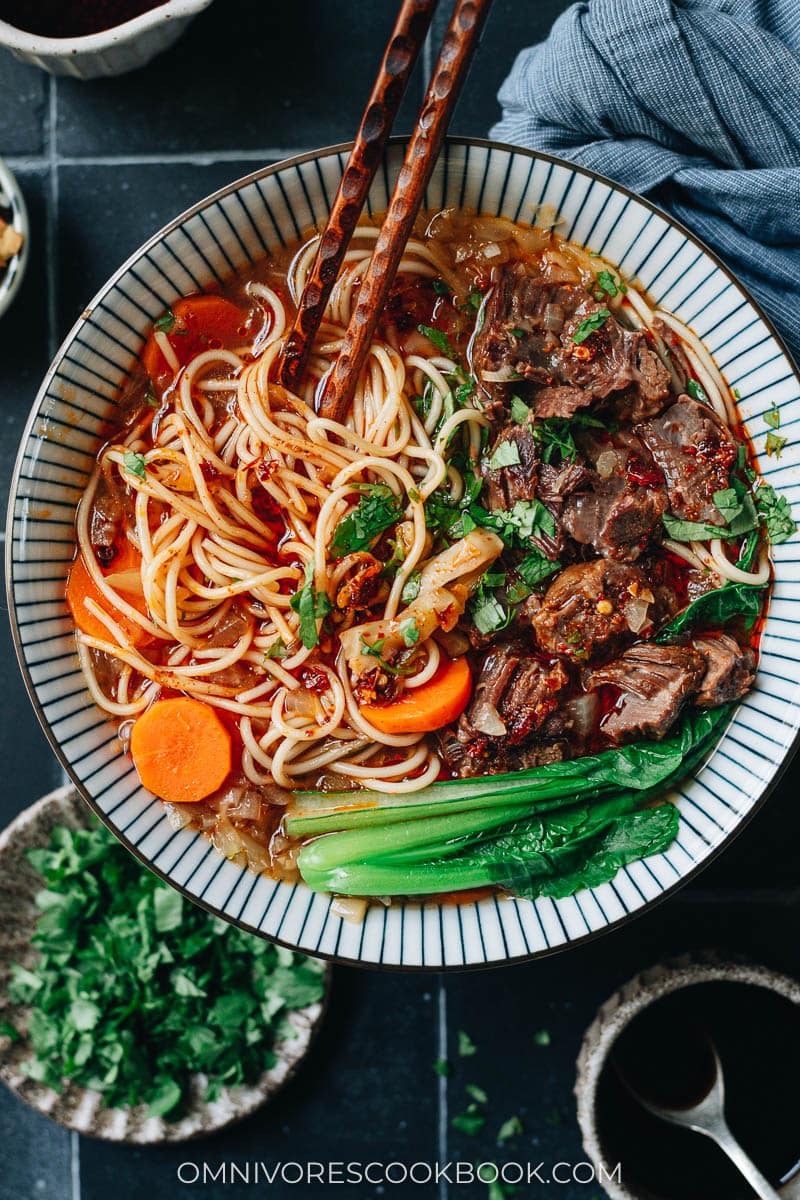
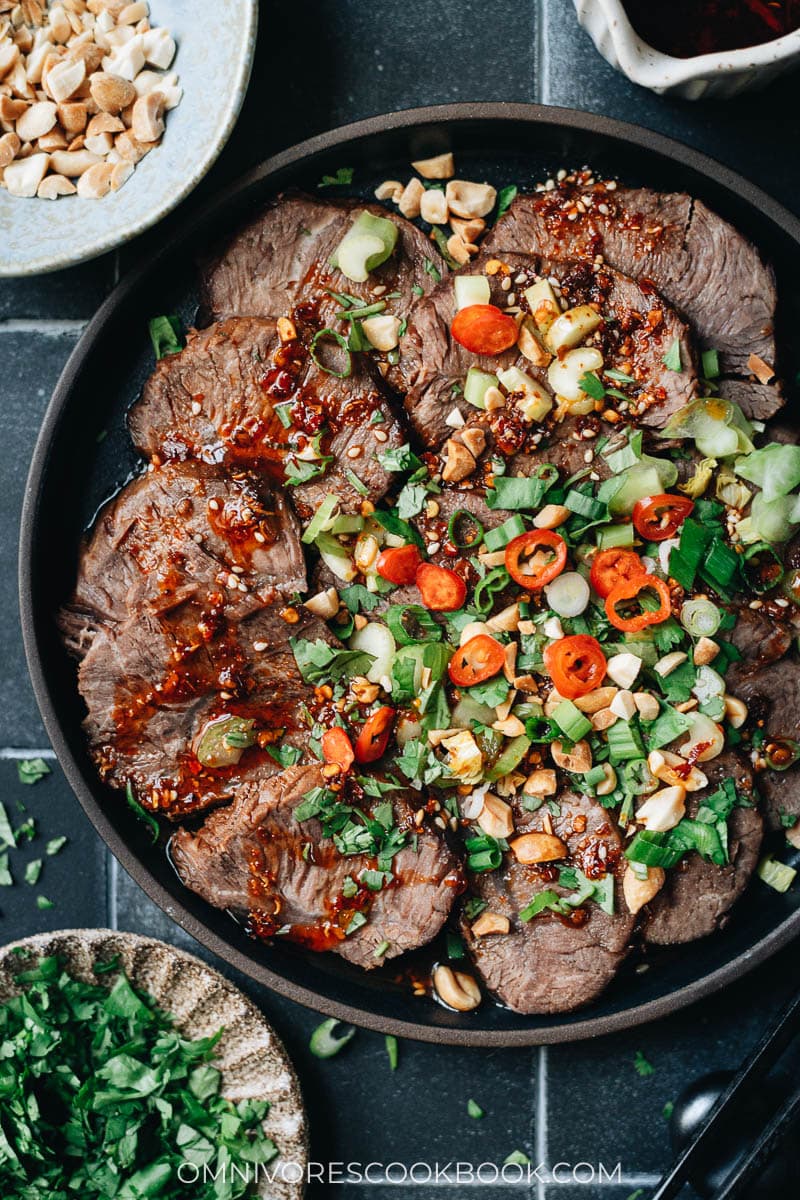
Glenn
Delicious with a beautiful depth of flavor. I will definitely make this again! The black cardamom is Cao Guo (草果), also called Chinese black cardamom. I just happened to have an unopened pack of it (thank you Maggie for helping me to identify it!) and I was so glad to finally get to use it! Thank you for this and all your beautiful recipes. Every one of them that I’ve made has turned out great!
Maggie Zhu
Hi Glenn, so happy to hear you enjoyed this dish and thanks for leaving a positive review 🙂 Always happy to help!
Marife
Hi! I wanted to try this recipe but I am just wondering if I could substitute the five spice powder into this if I do not have the other ingredient like the Star Anise? Thank you.
Maggie Zhu
You can definitely substitute with five spice but be careful about the amount. Because you don’t want to add too much that is overpowering. For this recipe I think you can add 1/2 teaspoon up to (and no more than) 1 teaspoon five spice, depending on what ingredients you don’t have.
MJ
Can I use eye of round instead of shank?
Maggie Zhu
I think you can, but the texture of the beef will be very different. If using shank, the connection tissuse will melt at the end of the cooking and makes the texture tender and juicy. Eye round is quite lean, so you won’t have the same texture. That being said, it’s totally OK to use eye round if you prefer a lean cut of beef.
MJ
Flavor will be about the same? Or do you think I need to change any part of your recipe?
Maggie Zhu
The flavor will be the same. The only thing I’m not sure is the cooking time. I did a brief research and the cooking time for eye of round varies significantly. I’ve seem recipes for 5 minutes cooking time, aiming for the medium rare texture in the center (I don’t think it would work here because there’s not enough time to let the meat soak in the flavors). Some recipes has super long cooking time (1 hr+) for shredded meat. I think the 35 to 40 mins cooking time should be able to cook through the meat and make it somewhat tender. But I’m not exactly sure about what is the best cooking time and you might want to braise the meat a bit more after the pressure cooking, if the texture has not achieve the desired tenderness.
Hsupit
Can you freeze it?
Maggie Zhu
Yes. The recipe freeze very well.
Angela
So simple and delicious! I’ve made this recipe several times and it always turns out perfectly, even when I’m missing a few ingredients. 😉
Isaac
Hi! Is the weight of the meat before or after cutting the meat from the bone?
Maggie Zhu
The weight is the meat without bones.
Isaac
Great! Also, I’m assuming it wouldn’t hurt to include the bones in the braising liquid?
Maggie Zhu
Of course! Adding bones in the braising liquid will make it much tastier 🙂
Menolly
So, I made this yesterday, blanched the beef and then braised at 300F in the oven for almost 4 hours, until the chuck roast still had some tooth, but was tender. House smelled heavenly. I put it in the fridge after it cooled down, to wait for for tonight.
Unfortunately, I woke up this morning with a mild case of food poisoning and bad stomach cramps and mild nausea that followed me most of the day, probably after eating a handfull of raw mung bean sprouts I’ve been growing last night (I didn’t know you needed to blanch them even if you grew them yourself. Now I do.)…
I’m not sure I’ll be ready for the beef Noodle soup tomorrow, we’ll see how I feel. Realistically, Saturday is more like it. Will it stay for in the fridge until then? If not, I could freeze it for a day, but I’m afraid to lose a lot of the spices flavors in the freeze.
Thanks for replying. I was really looking forward to this, so I’m really disappointed it’ll have to wait.
Maggie Zhu
Hi Menolly, I’m sorry to hear that you’re not feeling well. For the beef, it’s totally OK to store it in the fridge for a few days (I won’t store it over a week though).
Hope you’ll be feeling better soon and try out the noodle soup!
Joyce N
Hi Maggie. Haven’t reviewed in a while but still loving your recipes! Question: Can I sub beef digital muscle for the shanks if I want to use it in a soup? Thanks.
Maggie Zhu
Yes you can! It is a great cut to use in this recipe.
Joyce N
Lovely! Thanks so much!
S.B.
Could I add rehydrated hazel mushrooms (and the liquid) to this braise or is that not the right flavor profile?
Maggie Zhu
I think the mushroom will be a lovely addition! I love using hazel mushrooms as well especially for braising chicken, and it should work nicely with this dish. Happy cooking!
S.B.
I am planning to try this recipe this upcoming weekend. Love the recipes on your website. I made your braised chicken recipe with the hazel mushrooms instead of shitake mushrooms and it was delicious. Thanks for sharing!
Jim
Do I slice the shank before or after I Blanche it?
Maggie Zhu
Hi Jim, you should slice the shank before blanching.
Menolly
Does the blanching Liquid become the braising liquid? Or do you dump the liquid and aromatics you blanched the beef in and start over for the braising?
Maggie Zhu
Hi Menolly, I usually keep using the blanching liquid as the braising liquid.
Traditionally the blanching liquid is discarded, because in China the beef quality is usually not as good (sometimes not fresh) and the broth will have an unpleasant taste.
But I found the meat in the US is less gamey and I never had issue when not discarding the blanching liquid.
Menolly
Thank you! I’m going to make it this week end, and I’ll definitely post results. I found some “Wangzhihe Fermented Traditional Bean Curd” on Amazon. Will that work?
Maggie Zhu
It’s a lovely addition to the braising liquid! I would use 1 to 2 blocks.